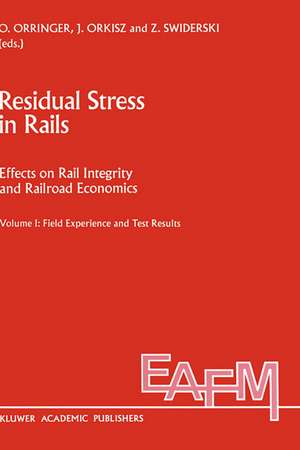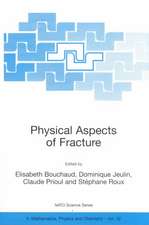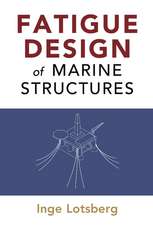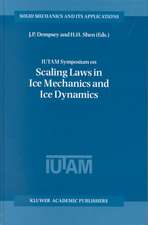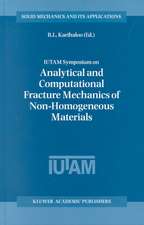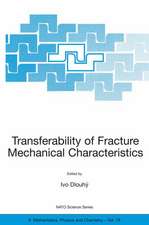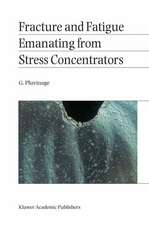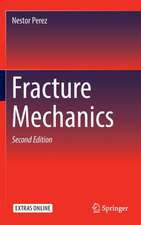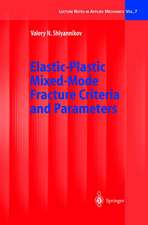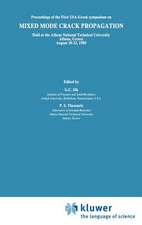Residual Stress in Rails: Effects on Rail Integrity and Railroad Economics Volume II: Theoretical and Numerical Analyses: Engineering Applications of Fracture Mechanics, cartea 12-13
Editat de O. Orringer, J. Orkisz, Zdzislaw Swiderskien Limba Engleză Hardback – 31 mar 1992
| Toate formatele și edițiile | Preț | Express |
|---|---|---|
| Paperback (1) | 1814.05 lei 43-57 zile | |
| SPRINGER NETHERLANDS – 3 oct 2012 | 1814.05 lei 43-57 zile | |
| Hardback (1) | 1819.14 lei 43-57 zile | |
| SPRINGER NETHERLANDS – 31 mar 1992 | 1819.14 lei 43-57 zile |
Preț: 1819.14 lei
Preț vechi: 2218.46 lei
-18% Nou
Puncte Express: 2729
Preț estimativ în valută:
348.10€ • 364.36$ • 289.72£
348.10€ • 364.36$ • 289.72£
Carte tipărită la comandă
Livrare economică 31 martie-14 aprilie
Preluare comenzi: 021 569.72.76
Specificații
ISBN-13: 9780792316510
ISBN-10: 0792316517
Pagini: 40
Ilustrații: XL, 447 p. In 2 volumes, not available separately.
Dimensiuni: 155 x 235 x 14 mm
Greutate: 0.51 kg
Ediția:1993
Editura: SPRINGER NETHERLANDS
Colecția Springer
Seria Engineering Applications of Fracture Mechanics
Locul publicării:Dordrecht, Netherlands
ISBN-10: 0792316517
Pagini: 40
Ilustrații: XL, 447 p. In 2 volumes, not available separately.
Dimensiuni: 155 x 235 x 14 mm
Greutate: 0.51 kg
Ediția:1993
Editura: SPRINGER NETHERLANDS
Colecția Springer
Seria Engineering Applications of Fracture Mechanics
Locul publicării:Dordrecht, Netherlands
Public țintă
ResearchCuprins
of Volume II.- 1. Residual stresses and web fracture in roller-straightened rail.- 1.1 Introduction.- 1.2 Determination of residual stresses.- 1.3 Effects of residual stresses on web fracture.- 1.4 A saw-cutting test to quantify severity of residual stresses.- 1.5 Stress transients and short cracks at rail ends.- 1.6 Creation of residual stresses: analyzing the roller-straightener.- 1.7 Conclusions.- Acknowledgements.- References.- 2. Some factors influencing the transition from shelling to detail fracture.- 2.1 Introduction.- 2.2 Crack path stability of statically growing shells.- 2.3 Dynamic crack curving.- 2.4 Calculation of shell growth rates.- 2.5 Conclusions.- Acknowledgement.- References.- 3. Analysis of crack front propagation in contact.- 3.1 Introduction.- 3.2 Existing theories and research objective.- 3.3 Two-dimensional model.- 3.4 Method of solution.- 3.5 Results.- 3.6 Conclusions.- 3.7 Appendix — matrix equations for contact solution.- References.- 4. Effect of load sequence on fatigue life of rail steel.- 4.1 Introduction.- 4.2 Strain energy density criterion.- 4.3 Material characterization.- 4.4 Load spectra.- 4.5 Finite element analysis.- 4.6 Discussion and conclusions.- References.- 5. On residual stresses in corrugated rails and wheel/rail interaction.- 5.1 Introduction.- 5.2 Simple models of wheel/rail interaction.- 5.3 Simulation of rolling contact process.- 5.4 Measurements of residual stresses in corrugated rail.- 5.5 Final remarks.- References.- 6. Prediction of actual residual stresses by constrained minimization of energy.- 6.1 Introduction.- 6.2 Mechanical models.- 6.3 Numerical models.- 6.4 Optimization strategy.- 6.5 Numerical results.- 6.6 Concluding remarks.- References.- 7. Hybrid finite element method for estimation of actual residualstresses.- 7.1 Introduction.- 7.2 Numerical approach.- 7.3 Performance tests.- 7.4 Example analysis of a rail.- 7.5 Discussion and conclusions.- References.- 8. Application of the constrained minimization method to the prediction of residual stresses in actual rail sections.- 8.1 Introduction.- 8.2 Background.- 8.3 Analysis method.- 8.4 Results.- 8.5 Discussion and conclusions.- References.- 9. Estimation of actual residual stresses by the boundary element method.- 9.1 Introduction.- 9.2 Estimation of residual stresses by the BEM.- 9.3 Results of numerical examples.- 9.4 Conclusions.- References.- 10. A new feasible directions method in nonlinear optimization.- 10.1 Introduction.- 10.2 New algorithm.- 10.3 Tests and comparisons.- 10.4 Concluding remarks.- References.- 11. Enhancement of experimental results by constrained minimization.- 11.1 Introduction.- 11.2 General formulation of the problem.- 11.3 Tests of enhancement concept.- 11.4 Conclusion.- References.- 12. On future development of the constrained energy minimization method.- 12.1 Introduction.- 12.2 Continuation of current work.- 12.3 New topics.- References.
